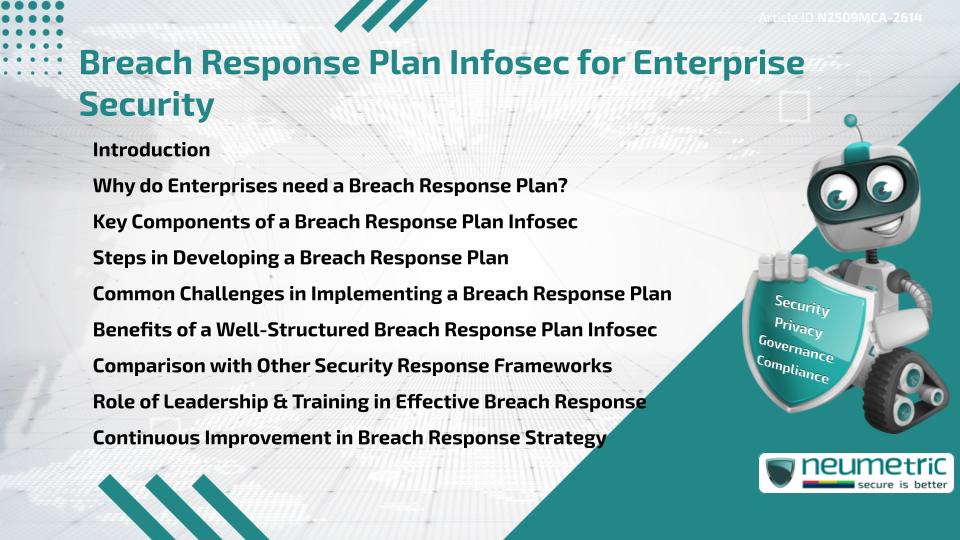Table of Contents
ToggleIntroduction
A Breach Response Plan Infosec is a structured Framework that enterprises use to prepare for, detect, respond to & recover from Security Incidents. It outlines the steps an organisation must take when faced with a Data Breach or Cyberattack, ensuring quick containment & minimal damage. Without such a Plan, enterprises Risk Regulatory penalties, Financial losses & Reputational harm. By implementing a Breach Response Plan, organisations can strengthen their Security posture, manage Data Protection Risks & enhance Stakeholder confidence.
Why do Enterprises need a Breach Response Plan?
The modern enterprise operates in a landscape where Cyber Threats are constant. Data breaches can arise from Malware, Phishing, Insider Threats or system Vulnerabilities. Having a Breach Response Plan Infosec is essential because:
- Regulators demand Accountability & Transparency in case of Breaches.
- Customers expect timely communication & protection of their data.
- A lack of preparation can turn a manageable Incident into a full-blown crisis.
In short, a Breach Response Plan is not just an operational tool but also a critical component of enterprise Risk Management.
Key Components of a Breach Response Plan Infosec
An effective Breach Response Plan includes:
- Preparation: Establishing Policies, Tools & Teams.
- Detection & Analysis: Identifying breaches & assessing their impact.
- Containment: Limiting the spread of the Breach.
- Eradication: Removing the root cause of the Incident.
- Recovery: Restoring systems & resuming Business Operations.
- Post-Incident Review: Learning lessons to strengthen future response.
These components ensure enterprises handle breaches in a systematic & efficient manner.
Steps in Developing a Breach Response Plan
Enterprises can follow these steps to build an actionable Breach Response Plan Infosec:
- Conduct a Risk Assessment: Identify potential Vulnerabilities & Threats.
- Form a Response Team: Assign roles & responsibilities across IT, legal, HR & Communications.
- Develop Communication Protocols: Establish internal & external communication strategies.
- Define Escalation Procedures: Outline when & how Incidents should be escalated.
- Test the Plan: Run tabletop exercises & simulations.
- Update Regularly: Revise the plan to reflect new Threats & Technologies.
Common Challenges in Implementing a Breach Response Plan
Despite its importance, enterprises face hurdles in implementing a Breach Response Plan Infosec:
- Insufficient resources for building & maintaining the plan.
- Lack of cross-department collaboration.
- Failure to update the plan in response to evolving Threats.
- Inadequate training & awareness among staff.
These challenges highlight the need for ongoing investment & cultural integration.
Benefits of a Well-Structured Breach Response Plan Infosec
Enterprises that maintain a robust plan benefit in several ways:
- Faster detection & response times.
- Reduced Financial & Reputational impact.
- Improved Compliance with Data Protection regulations.
- Greater Trust among Customers, Partners & Regulators.
- Stronger Resilience against Future Cyber Threats.
The plan serves as both a shield & a roadmap for recovery.
Comparison with Other Security Response Frameworks
The Breach Response Plan Infosec can be compared with the NIST Cybersecurity Framework & the ISO/IEC 27035 Incident Management Standard. While the NIST Framework focuses broadly on Cybersecurity practices & ISO/IEC 27035 provides structured Incident Management guidelines, a Breach Response Plan is more tailored to the specific context of an organisation. This adaptability makes it a practical choice for enterprises that need a customised approach.
Role of Leadership & Training in Effective Breach Response
Leadership commitment is crucial to ensure Resources, Governance & Accountability for Breach response. At the same time, training empowers Employees to detect & escalate Incidents quickly. Without strong leadership & consistent training, even the most detailed Breach Response Plan will fail during a real Incident.
Continuous Improvement in Breach Response Strategy
A Breach Response Plan must evolve with the Threat landscape. Enterprises should:
- Conduct regular Simulations & Reviews.
- Monitor new Technologies & Attack Vectors.
- Incorporate lessons learned from past Incidents.
- Update Response Procedures to match emerging Risks.
This Continuous Improvement ensures that the plan remains effective & relevant.
Takeaways
- A Breach Response Plan Infosec prepares enterprises to handle Security Incidents efficiently.
- It includes preparation, detection, containment, eradication, recovery & review.
- Common challenges include resource constraints, poor collaboration & lack of training.
- Benefits include faster response times, reduced impact & improved trust.
- Continuous Improvement keeps the plan aligned with evolving Threats.
FAQ
What is a Breach Response Plan Infosec?
It is a structured strategy that enterprises use to prepare for, respond to & recover from Data Breaches or Cyberattacks.
Why is a Breach Response Plan Infosec important?
It reduces Financial, Reputational & Regulatory Risks while improving enterprise Security & Resilience.
What are the main components of a Breach Response Plan Infosec?
The components include preparation, detection, containment, eradication, recovery & post-incident review.
Who should be part of the breach response team?
Typically, IT, legal, human resources, Compliance & communications teams work together as part of the Breach Response Team.
How often should the Breach Response Plan Infosec be updated?
It should be reviewed & updated regularly, ideally after significant Incidents, Regulatory changes or annual Risk Assessments.
How does a Breach Response Plan differ from the NIST Cybersecurity Framework?
The NIST Cybersecurity Framework provides a broad Cybersecurity guideline, while a Breach Response Plan is organisation-specific & focused on Incident Handling.
Can small enterprises also use a Breach Response Plan Infosec?
Yes, the plan is scalable & can be adapted to fit the resources & Risks of smaller organisations.
Need help for Security, Privacy, Governance & VAPT?
Neumetric provides organisations the necessary help to achieve their Cybersecurity, Compliance, Governance, Privacy, Certifications & Pentesting needs.
Organisations & Businesses, specifically those which provide SaaS & AI Solutions in the Fintech, BFSI & other regulated sectors, usually need a Cybersecurity Partner for meeting & maintaining the ongoing Security & Privacy needs & requirements of their Enterprise Clients & Privacy conscious Customers.
SOC 2, ISO 27001, ISO 42001, NIST, HIPAA, HECVAT, EU GDPR are some of the Frameworks that are served by Fusion – a SaaS, multimodular, multitenant, centralised, automated, Cybersecurity & Compliance Management system.
Neumetric also provides Expert Services for technical security which covers VAPT for Web Applications, APIs, iOS & Android Mobile Apps, Security Testing for AWS & other Cloud Environments & Cloud Infrastructure & other similar scopes.
Reach out to us by Email or filling out the Contact Form…





